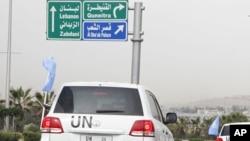The U.N.’s peacekeeping chief said Tuesday that the Syrian government still has heavy weapons in cities, and that both the government and opposition have committed violations of a U.N.-brokered truce.
U.N. peacekeeping chief Hervé Ladsous says the 24 monitors already in Syria have reported heavy weapons are still in several cities - a violation of the peace deal brokered by U.N.-Arab League mediator Kofi Annan.
“Yes, our military observers do see a number of APCs [armored personnel carriers], for instance, they see a number of howitzers and other military equipment in most places where they are. It is being claimed the APCs have been disarmed, but that is not verified in all cases,” Ladsous said.
Ladsous said the level of violence has been “appalling” and urged both sides to respect the cessation of hostilities. He said the monitors have reported violations from both government forces and the opposition.
“I think the violations that are observed come from both sides. I would not establish ratio, I think now is perhaps not the time, since after all, we still have a limited number of observers in a limited number of localities. The fact is, I think politically, the important fact is, that violations do come from both sides,” Ladsous said.
On Monday, Syrian state media reported several attacks on government buildings in the northern city of Idlib, which killed mostly security forces, while the opposition reported that government bombings killed several civilians in Idlib on Tuesday.
Meanwhile, the United Nations is working to deploy the full monitoring mission. Ladsous said 24 observers are now in Syria and he expects that number to rise to rapidly, with the full deployment of about 300 to be in place by the end of May.
He acknowledged that the United Nations only has “solid” commitments from member states for half the force so far. But despite the shortfall, he said he is confident to have the full 300 by the end of the month.
The mission faces other challenges, including the ability to move freely in Syria. Ladsous said the United Nations is still negotiating an agreement with Damascus regarding whose helicopters would be used - Syria’s or the U.N.’s - to ferry observers around the large country.
There are also security challenges. In a country where more than 9,000 people have died in the past 13 months, the observers are unarmed and beholden to the Syrian military for their protection, even when they enter areas controlled by the opposition. They also are operating in a country where a cessation of hostilities has been in name only.
The U.N. Security Council authorized the observer mission for an initial deployment of 90 days. The United States has said it may not vote to renew the mandate if there is not a sustained cessation of hostilities, full freedom of movement for the mission and real progress on the other points in Kofi Annan’s peace plan.









